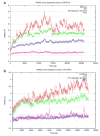A computational modeling and molecular dynamics study of the Michaelis complex of human protein Z-dependent protease inhibitor (ZPI) and factor Xa (FXa)
- PMID: 19172319
- PMCID: PMC2723763
- DOI: 10.1007/s00894-008-0444-3
A computational modeling and molecular dynamics study of the Michaelis complex of human protein Z-dependent protease inhibitor (ZPI) and factor Xa (FXa)
Abstract
Protein Z-dependent protease inhibitor (ZPI) and antithrombin III (AT3) are members of the serpin superfamily of protease inhibitors that inhibit factor Xa (FXa) and other proteases in the coagulation pathway. While experimental structural information is available for the interaction of AT3 with FXa, at present there is no structural data regarding the interaction of ZPI with FXa, and the precise role of this interaction in the blood coagulation pathway is poorly understood. In an effort to gain a structural understanding of this system, we have built a solvent equilibrated three-dimensional structural model of the Michaelis complex of human ZPI/FXa using homology modeling, protein-protein docking and molecular dynamics simulation methods. Preliminary analysis of interactions at the complex interface from our simulations suggests that the interactions of the reactive center loop (RCL) and the exosite surface of ZPI with FXa are similar to those observed from X-ray crystal structure-based simulations of AT3/FXa. However, detailed comparison of our modeled structure of ZPI/FXa with that of AT3/FXa points to differences in interaction specificity at the reactive center and in the stability of the inhibitory complex, due to the presence of a tyrosine residue at the P1 position in ZPI, instead of the P1 arginine residue in AT3. The modeled structure also shows specific structural differences between AT3 and ZPI in the heparin-binding and flexible N-terminal tail regions. Our structural model of ZPI/FXa is also compatible with available experimental information regarding the importance for the inhibitory action of certain basic residues in FXa.
Conflict of interest statement
Figures







Similar articles
-
Basis for the specificity and activation of the serpin protein Z-dependent proteinase inhibitor (ZPI) as an inhibitor of membrane-associated factor Xa.J Biol Chem. 2010 Jun 25;285(26):20399-409. doi: 10.1074/jbc.M110.112748. Epub 2010 Apr 28. J Biol Chem. 2010. PMID: 20427285 Free PMC article.
-
Identification of factor Xa residues critical for interaction with protein Z-dependent protease inhibitor: both active site and exosite interactions are required for inhibition.J Biol Chem. 2005 Sep 23;280(38):32722-8. doi: 10.1074/jbc.M505517200. Epub 2005 Aug 3. J Biol Chem. 2005. PMID: 16079143 Free PMC article.
-
Inhibitory properties of the P1 Tyr variant of antithrombin.Biochemistry. 2010 Mar 30;49(12):2680-6. doi: 10.1021/bi100120a. Biochemistry. 2010. PMID: 20184328 Free PMC article.
-
Determinants of specificity of factor xa interaction with its physiological inhibitors.Mini Rev Med Chem. 2006 Aug;6(8):859-65. doi: 10.2174/138955706777935017. Mini Rev Med Chem. 2006. PMID: 16918492 Review.
-
Protein Z-dependent regulation of coagulation.Thromb Haemost. 2001 Jul;86(1):8-13. Thromb Haemost. 2001. PMID: 11487045 Review.
Cited by
-
Unconstrained Enhanced Sampling for Free Energy Calculations of Biomolecules: A Review.Mol Simul. 2016;42(13):1046-1055. doi: 10.1080/08927022.2015.1121541. Epub 2016 Jul 5. Mol Simul. 2016. PMID: 27453631 Free PMC article.
-
Mechanism of protein-z-mediated inhibition of coagulation factor xa by z-protein-dependent inhibitor: a molecular dynamic approach.ISRN Hematol. 2012;2012:762728. doi: 10.5402/2012/762728. Epub 2012 Mar 20. ISRN Hematol. 2012. PMID: 22536522 Free PMC article.
-
Uncovering Membrane-Bound Models of Coagulation Factors by Combined Experimental and Computational Approaches.Thromb Haemost. 2021 Sep;121(9):1122-1137. doi: 10.1055/s-0040-1722187. Epub 2021 Jul 2. Thromb Haemost. 2021. PMID: 34214998 Free PMC article. Review.
-
Inhibitors of SARS-3CLpro: virtual screening, biological evaluation, and molecular dynamics simulation studies.J Chem Inf Model. 2011 Jun 27;51(6):1376-92. doi: 10.1021/ci1004916. Epub 2011 May 23. J Chem Inf Model. 2011. PMID: 21604711 Free PMC article.
-
Force-momentum-based self-guided Langevin dynamics: a rapid sampling method that approaches the canonical ensemble.J Chem Phys. 2011 Nov 28;135(20):204101. doi: 10.1063/1.3662489. J Chem Phys. 2011. PMID: 22128922 Free PMC article.
References
-
- Gettins PG. Serpin structure, mechanism, and function. Chem Rev. 2002;102:4751–4804. - PubMed
-
- Han X, Huang Z-F, Fiehler R, Broze GJ., Jr The protein Z-dependent protease inhibitor is a serpin. Biochemistry. 1999;38:11073–11078. - PubMed
-
- Han X, Fiehler R, Broze GJ., Jr Characterization of the protein Z-dependent protease inhibitor. Blood. 2000;96:3049–3055. - PubMed
-
- Heeb MJ, Cabral KM, Ruan L. Down-regulation of factor IXa in the factor Xase complex by protein Z-dependent protease inhibitor. J Biol Chem. 2005;280:33819–33825. - PubMed
Publication types
MeSH terms
Substances
Grants and funding
LinkOut - more resources
Full Text Sources
Miscellaneous

